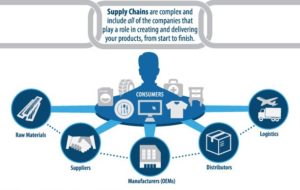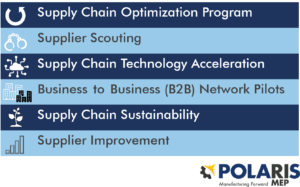By Gregg Profozich, Director, Advanced Manufacturing Technologies, California Manufacturing Technology Consulting (CMTC)
As acquiring parts and resources becomes more challenging, supplier sourcing has grown in popularity, offering long-term, reliable solutions to small and medium-sized manufacturers in Rhode Island and across the country.
 Due in large part to global supply chain disruptions, many small and medium-sized manufacturers (SMMs) are experiencing difficulties securing supplies of essential products needed to maintain their daily operations. To overcome this challenge, SMMs are devising new approaches to acquire the materials they need to adapt to this uncertain economic environment.
Due in large part to global supply chain disruptions, many small and medium-sized manufacturers (SMMs) are experiencing difficulties securing supplies of essential products needed to maintain their daily operations. To overcome this challenge, SMMs are devising new approaches to acquire the materials they need to adapt to this uncertain economic environment.
This post is an introduction to Supplier Sourcing as a solution for RI manufacturers.
What is Supplier Sourcing in Supply Chain Management?
 Aside from creating a network of vendors to fulfill operational needs, supplier sourcing is also concerned with building a robust supply chain that is organized, streamlined, and flexible enough to navigate ongoing uncertainties in the market.
Aside from creating a network of vendors to fulfill operational needs, supplier sourcing is also concerned with building a robust supply chain that is organized, streamlined, and flexible enough to navigate ongoing uncertainties in the market.
Additional aspects of supplier sourcing involve
- vetting various vendors, negotiating contracts, and coming to an agreement over payment terms;
- conducting the necessary research to find the best possible solution to supply chain problems, such as relying on outsourcing to create select products; and
- developing standards for vendors to follow that align with an SMM’s expectations and timelines.
How Supplier Sourcing Benefits SMMs Now and in the Future
Supplier sourcing provides numerous benefits to SMMs, allowing them to overcome a range of emerging supply chain challenges. According to Harry Moser, Founder of the Reshoring Initiative, solid supplier sourcing can help to identify redundant suppliers and ensure companies are not fully dependent on a single source for their goods or services.
In addition, supplier sourcing can potentially help SMMs build a more resilient supply chain by nearshoring or reshoring critical suppliers.
Aside from these benefits, there are several other ways supplier sourcing can help SMMs optimize and improve their operations.
 Cost Management
Cost Management
Since supplier sourcing gives SMMs access to a broader network of vendors to choose from, it’s much easier to negotiate for better prices on high-volume orders. Over time, these negotiations can lower the costs of sourcing goods while ensuring retail prices remain competitive.
Other cost-related issues supplier sourcing can help resolve include:
Limited Liquidity
When cash flow is tight, SMMs can struggle to cover the expenses they need to grow. By compiling a wider list of potential suppliers, companies may discover better financing options that can improve their financial situation.
High Costs
Time spent on finding and vetting suppliers on the fly means more money spent on rising overhead costs. With supplier sourcing, SMMs can pivot to reputable vendors faster rather than search for a replacement. Aside from reducing procurement costs, supplier sourcing allows companies to allocate labor and resources to other areas of the business, improving overall productivity.
Poor Supplier Relationships
A negative relationship with a particular supplier can contribute to inflated prices, miscommunication, and costly delays in products or services. With supplier sourcing, businesses can build a repository of reputable suppliers who are aligned with their values, needs, and expectations. SMMs can facilitate more efficient operations with fewer costly delays or disruptions by forging better relationships with a number of suppliers.
 Stability
Stability
Developing a supplier sourcing strategy puts small and medium-sized manufacturers on solid footing, improving their stability in today’s unpredictable market. Thanks to the improved efficiency that supplier sourcing provides, SMMs can spend less on higher-quality goods or services, providing businesses with a sturdy foundation to facilitate further growth in the industry. Working with more effective suppliers also alleviates problems with supply chain disruptions that can cut into revenues or even cause customers to move on to a competitor.
 Risk Management
Risk Management
Supplier sourcing can also help SMMs with navigating risk management in their supply chain. With greater access to an expansive network of suppliers, SMMs gain access to knowledge, resources, and manpower they wouldn’t have otherwise.
Having a reliable pool of diverse suppliers makes it possible to mitigate an array of risks that can undermine productivity. For instance, if a natural disaster shuts down a particular supplier, it’s possible to quickly connect with alternative suppliers in the network to handle the work. For companies lacking the finances or resources to absorb losses from supply chain disruptions, this risk mitigation can prove critical to maintaining a competitive edge.
 Relationship Building
Relationship Building
Supplier sourcing improves how vendors and SMMs interact, collaborate, and communicate, opening the door to more fruitful partnerships overall. As supplier sourcing continues to gain momentum in the manufacturing industry, companies are beginning to connect with entirely new suppliers capable of providing flexible long- and short-term solutions to complex obstacles. Given time, having access to this expanding network of suppliers may support reshoring that allows SMMs to create a more efficient supply chain network.
5 Steps for Successful Supplier Sourcing
When done correctly, supplier sourcing can be a straightforward task. Here are five steps to begin sourcing suppliers today:
 Step 1: Align Your Supplier Sourcing Strategy with Your Business Strategy
Step 1: Align Your Supplier Sourcing Strategy with Your Business Strategy
The supplier sourcing process starts with developing a strategy for finding suppliers that closely align with the SMM’s business objectives. If reducing costs is a priority, focus on finding suppliers who provide competitive quotes for high-demand products or services. If the goal is to break into an entirely new market, the best suppliers should have considerable experience with that market and the unique challenges it presents. In other words, the sourcing strategy of a company should coincide with its general business strategy.
Step 2: Conduct Some Research
Next, search online to gain insights into the reputations of different suppliers. The Better Business Bureau is an excellent repository of information regarding any customer complaints about a supplier. It’s also a good idea to check the social media accounts of suppliers to learn more about their customers’ experiences. When in doubt, request references for suppliers to verify their experience and ability to meet customer expectations.
After building a shortlist of quality suppliers, you can start homing in on the best options by evaluating certain criteria including how long they’ve been in business, how flexible they are on delivery timetables, and whether or not they’re willing to negotiate on pricing.
Step 3: Contact Preferred Suppliers and Begin Negotiating
At this point, it’s time to start reaching out to suppliers to discuss pricing, delivery schedules, high-volume order discounts, minimum order quantities (MOQs), and payment terms. Ideally, the right supplier should be able to meet all of your requirements and be open to negotiating an arrangement that works for both parties. If a supplier isn’t open to adjusting a few variables to meet your business needs, it may be best to contact alternative vendors.
Step 4: Weigh Your Options
Once you’ve reached out to your preferred options and received various quotes, it’s time to determine the best supplier for your operation’s current needs. Be sure to consider quality, customer service, and overall value when comparing different options. Don’t forget to include hidden costs in the decision-making process, such as embedded shipping and handling fees or any other charges that can drive up costs.
Step 5: Select a Supplier and Draft a Contract
After finding the appropriate supplier to provide a product or service, you’re ready to draw up a contract. To expedite the process, it’s often a good idea to hire an attorney who knows how to navigate contract negotiations and can address any concerns along the way.
Aside from outlining payment terms and delivery times, the contract should outline the potential liabilities of both you (the buyer) and the supplier if either party neglects to fulfill their end of the agreement.
When finalizing a contract with a vendor, be sure to double-check key terms such as the length of the contract, the quality of goods or services rendered, and what kind of indemnity clauses protect either party from negligence-related losses. In addition, the contract should outline the course of action to take should either party breach the terms of the contract.
Once signed by you and the supplier, the contract becomes legally enforceable, ensuring both parties are obligated by law to follow through with the agreement. At this point, the working relationship between the company and the vendor can begin.
Consider Seeking Expert Help with Supplier Sourcing
 Supplier sourcing for successful supply chain management does require some education to properly navigate, so it’s a good idea to find experienced help if you need it. Working with an experienced professional in sourcing products or services can mitigate many of the risks associated with ineffective supplier partnerships.
Supplier sourcing for successful supply chain management does require some education to properly navigate, so it’s a good idea to find experienced help if you need it. Working with an experienced professional in sourcing products or services can mitigate many of the risks associated with ineffective supplier partnerships.
Experts in the field know how to limit an SMM’s exposure to potentially bad contracts that drive up costs and undermine efficiency. Meanwhile, having access to a sourcing expert can help inform future contract negotiations and can even assist with identifying unique opportunities that were otherwise overlooked.
How Polaris MEP and the MEP National Network Help SMMs with Supplier Sourcing
Our Supplier Scouting services team has a depth of experience and understanding of supply chain and has access to a broad range of manufacturers across the United States via the MEP National Network.
Project Manager Chris Cinieri leads this effort for Rhode Island’s manufacturers. His approach is to match locally first, if possible, then expand the search to the region and then the nation.
Whatever your supply chain challenge is, we’re here to help — contact Chris today!
About the Author
Like Polaris MEP, California Manufacturing Technology Consulting (CMTC) is part of the Hollings Manufacturing Extension Partnership (MEP) Program.
Gregg Profozich serves as Director, Advanced Manufacturing Technologies for the CMTC. He is a manufacturing, operations and technology executive who believes that manufacturing is the key creator of wealth in the economy and that a strong manufacturing sector is critical to our nation’s prosperity and security now, and for future generations. Across his 20-year plus career in manufacturing, operations and technology consulting, Mr. Profozich helped manufacturing companies from the Fortune 500 to the small, independents significantly improve their productivity and competitiveness.

 Cost Management
Cost Management Stability
Stability Risk Management
Risk Management Relationship Building
Relationship Building